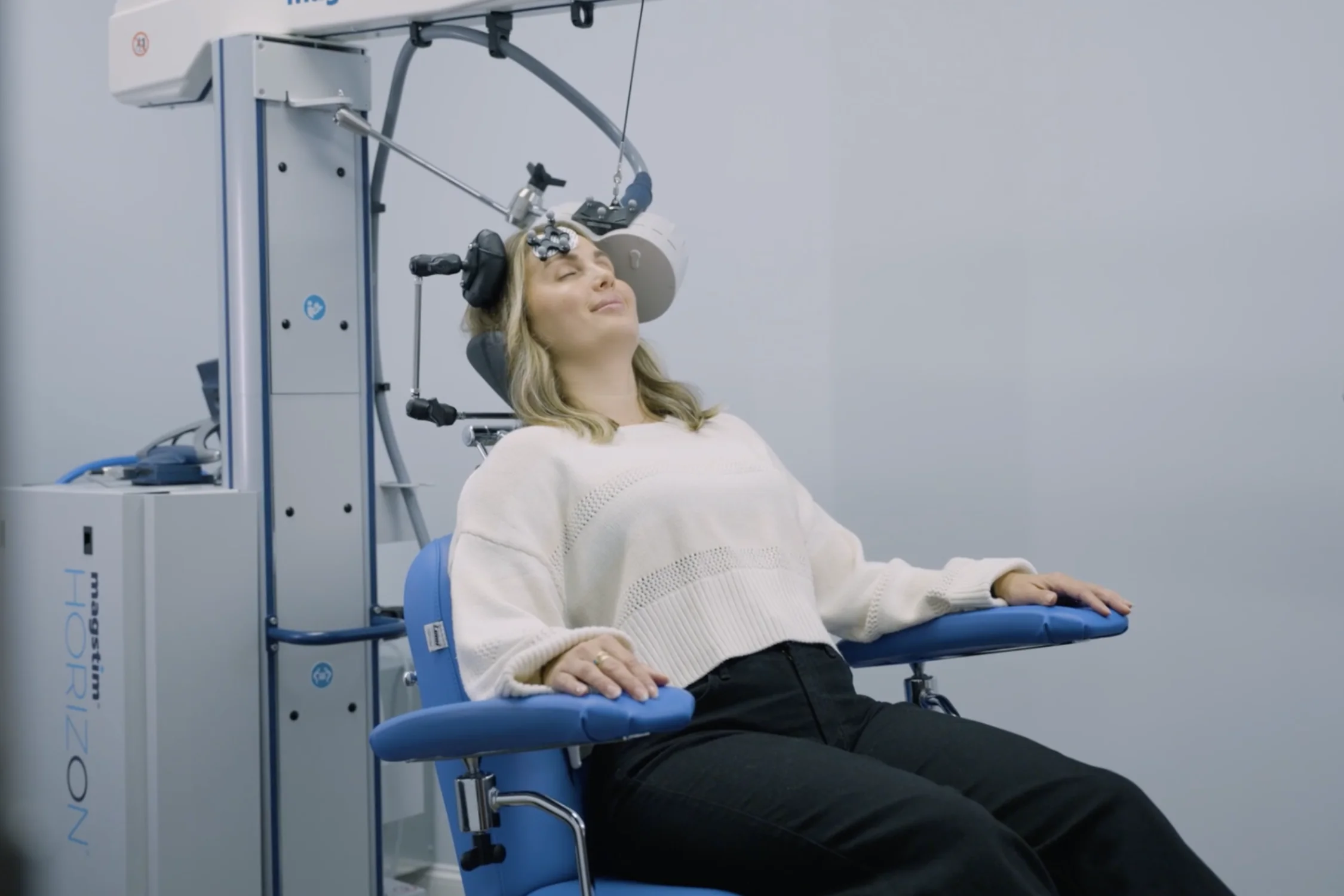Transcranial Magnetic Stimulation (TMS) Therapy for Addiction Recovery

At Discovery Point Retreat in Dallas, Texas, we offer TMS therapy for addiction recovery—a non-invasive, evidence-based approach that is transforming how people heal from substance use disorders. When paired with therapy, medical care, and wellness support, TMS addiction treatment helps clients regain control, reduce cravings, and build lasting sobriety.
TMS is trending in advanced addiction recovery because it targets specific brain regions linked to cravings, mood, and decision-making. In this post, we’ll explain how TMS therapy for addiction recovery works, review the latest research, explore real-life examples, and show how we integrate it into a holistic treatment plan.
What Is TMS Therapy and Why It Matters
Transcranial Magnetic Stimulation (TMS) uses focused magnetic pulses to stimulate areas of the brain involved in addiction, impulse control, and emotional regulation. By enhancing neural activity in these regions, TMS helps rebalance brain chemistry, making cravings easier to manage, mood more stable, and focus sharper.
Unlike medications or invasive procedures, TMS is non-invasive and generally well-tolerated. Clients can continue their daily routines throughout the course of treatment.
How TMS Supports Addiction Recovery
Reduction of Cravings
TMS targets the dorsolateral prefrontal cortex (DLPFC), a key area for regulating cravings. Research shows that repetitive TMS (rTMS) can significantly reduce cravings for alcohol, stimulants, and tobacco. High-frequency stimulation of the left DLPFC is particularly effective. For example, a client struggling with alcohol use may notice fewer urges in social situations after several TMS sessions.
Easing Withdrawal Symptoms
Withdrawal can be one of the most stressful stages of recovery, often accompanied by anxiety, irritability, and mood swings. By stabilizing overactive neural circuits, TMS can make early recovery more manageable. Clients often report feeling calmer and more emotionally balanced during this critical stage.
Improving Mood and Cognitive Function
Addiction often affects attention, memory, and emotional control. TMS has been shown to improve neural connectivity, helping clients think more clearly, focus on daily tasks, and regulate emotions more effectively. For instance, someone recovering from methamphetamine use may find it easier to concentrate on work or school and manage stress after consistent TMS treatment.
Safe, Non-Invasive, and Low Side-Effect Profile
Most clients experience only mild tingling on the scalp or a brief headache. Because TMS does not involve surgery or anesthesia, it is a low-risk, well-tolerated option for advanced addiction care.
Evidence and Research
Emerging studies show TMS therapy for addiction recovery is effective across multiple substance use disorders:
- Alcohol Use Disorder (AUD): High-frequency TMS over the DLPFC can reduce cravings and alcohol consumption, helping clients stay engaged in therapy and daily life.
- Cocaine and Methamphetamine Use: TMS can lower cravings and improve focus, attention, and emotional regulation.
- Opioid Use Disorder: Early studies suggest TMS may reduce cue-induced cravings and support long-term abstinence, especially with deep TMS techniques.
Combining TMS with therapy or medication-assisted treatment often produces stronger outcomes than using any single treatment alone. This integration makes TMS addiction treatment a powerful complement to holistic recovery programs.
Integrating TMS into Holistic Recovery
At Discovery Point Retreat, we view TMS therapy for addiction recovery as a complement to comprehensive care. While TMS helps reduce cravings and stabilize mood, sustainable recovery comes from addressing the whole person—physical, emotional, and social well-being.
- Individual and Group Therapy: TMS supports engagement in psychotherapy by helping clients manage cravings and emotions more effectively. Therapy addresses triggers, trauma, and coping strategies.
- Nutritional and Wellness Support: Balanced nutrition supports brain health, enhances TMS outcomes, and improves mood, energy, and focus.
- Medical Oversight: Our team monitors health, medications, and withdrawal symptoms, ensuring TMS is safe and effective.
- Aftercare and Relapse Prevention: Long-term recovery is supported with ongoing therapy, support groups, life skills, and relapse prevention strategies.
This integrated approach ensures clients not only benefit from TMS addiction treatment but also build the skills and support networks needed for lasting sobriety.
What to Expect During TMS Sessions
Assessment and Brain Mapping
Before your first session, we evaluate mood, cravings, and cognitive function, identifying the optimal brain regions to target—often the DLPFC.
Session Procedure
You’ll sit comfortably while a magnetic coil delivers pulses to the targeted area. Sessions last 20–40 minutes, with no anesthesia required.
Sensations
Most clients feel a gentle tapping or tingling. Mild headaches may occur but resolve quickly.
Treatment Schedule
Standard protocols involve 5 sessions per week for 4–6 weeks, but we customize schedules to individual needs.
Progress Tracking
We monitor cravings, mood, and cognitive function throughout the program. Many clients notice early changes within 2–3 weeks, with full benefits emerging over the treatment course.
Who Can Benefit from TMS Therapy for Addiction Recovery
TMS may be especially helpful for individuals who:
- Have not fully responded to traditional therapies
- Seek a non-invasive alternative without surgery or daily medications
- Are ready to actively engage in a structured recovery program
While TMS is not a standalone cure, it is a powerful adjunct that strengthens recovery when combined with holistic care.
Frequently Asked Questions (FAQs)
Is TMS safe for everyone?
TMS is generally safe and well-tolerated. Our medical team screens each client to ensure it’s appropriate for their specific health profile.
How soon will I see results?
Many clients notice reduced cravings and improved mood within 2–3 weeks, though full benefits typically appear over the full treatment course.
Does TMS replace therapy or medications?
No. TMS is most effective when combined with psychotherapy, medication-assisted treatment, and holistic wellness strategies.
Can I continue daily activities during TMS treatment?
Yes. TMS is non-invasive and doesn’t require anesthesia, so clients can return to work, school, or daily routines immediately after sessions.
Ready to Learn More?
If you are curious about how TMS therapy for addiction recovery can support your journey, Discovery Point Retreat is here to guide you. Contact us today to schedule a consultation and discover whether TMS is the right fit for your recovery path.
SOURCES:
Why TMS is considered non-invasive and well-tolerated:

